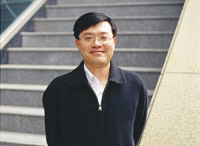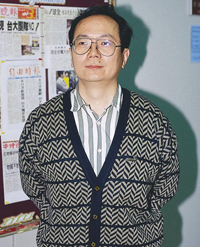

 |
|||
|
::: NTU's High Energy Physics Group Solves the Mystery of the Disappearance of Antimatter in the Universe: Collaborating with the KEK of Japan, NTU's Research Paper Was Published in the Prestigious "Nature" Journal
As a participating member of the high energy physics group of NTU, Professor Chang points out that, to explain the phenomenon of the disappearance of the antimatter from the universe, one must understand that matter and antimatter are somewhat different in their basic characteristics. This is what the physicists labeled as the "charge parity violation" phenomenon. The said phenomenon was first discovered in 1964, but the disparity observed in a laboratory, when applied to the "standard model" in modern fundamental particle physics, could only explain 1/10000000000th of the imbalance between matter and antimatter, obviously lacking in its explanatory power. Thus, the common dream of high energy physicists, is to actively engage in the research of charge parity violation, in the hope of discovering a new physics principle that transcends the "standard model", which could explain why the modern world could exist as it is. The NTU high energy physics group has participated in the KEK Belle Lab B meson factory international experiment in Tsukuba, Japan, for many years. Recently the group discovered that in the course of a charged B meson decaying into a K meson and a p meson, its direct charged parity asymmetry is not the same as the asymmetry derived from a neutral B meson decaying into a Kp meson. The difference in the two direct charged disparities could have been caused by a new physics principle which we have no knowledge about. Therefore, the result of this experiment could provide clues to solve the mystery of the antimatter disappearing from the universe. The study of charge parity violation requires large amount of precise data, because the particle phenomena is very sophisticated. At the end of the twentieth century, there were only two B meson factories built for the purpose of conducting research on charge parity violations—the KEK's Belle Lab In Japan and the BaBar Lab in Standford's SLAC Center. When these two labs were established, NTU's high energy physics group was invited to join them. A group of scientists led by Professor George Wei-shu Hou (a physical theorist) wanted to fulfill their dreams—embarking upon the international arena to do first rate research, so they joined the B meson factory experiment of Japan. Starting from a small team of four persons, the group now has expanded into a team of more than 30 people, with copious results in research and international competitiveness. Whereas the group only occupies about 1/20th of the manpower of the Belle lab, it has published about 50 theses, roughly 1/5th of the total number of theses published by the Belle Lab. In addition, in 2004 the research team found evidence of direct charge parity violation in neutral B meson decays. Their research achievement was considered to be the most important results in the high energy physics field of that year. The treatise published in "Nature" reported that, in the process of B meson decaying into Kp meson, charged and neutral B mesons displayed tremendous differences in their charge parity violations. These differences countered the original theoretical anticipations. The bottom line is—what caused these differences? Many theorists admit, the standard model is hardly sufficient to provide an explanation, so the phenomenon is termed as the K-p puzzle. Some theorists tried to explain the phenomenon by using the strong force interaction theory, and some maintained that the puzzle could have been caused by a new physics principle that surmounts the standard model. With our understanding of the particle physics today, if the difference is caused by the strong force interaction, we need to make considerable amendments of our comprehension of the strong force interaction of the B meson decay theory. This is why the editorial board of "Nature" highly confirmed the research results of the NTU high energy physics group, and made the treatise become one of the rare articles published in the journal relating to high energy physics. Professor Pao-ti Chang's Website:http://www.phys.ntu.edu.tw/member/main1.aspx?skey=75 Professor George Wei-shu Hou's Website:http://www.phys.ntu.edu.tw/member/main1.aspx?skey=35 Copyright 2008 NTU Secretariat |
No. 1, Sec. 4, Roosevelt Road, Taipei, 10617 Taiwan(R.O.C.)
Phone: +886-2-3366-3366 Fax: +886-2-2362-7651
